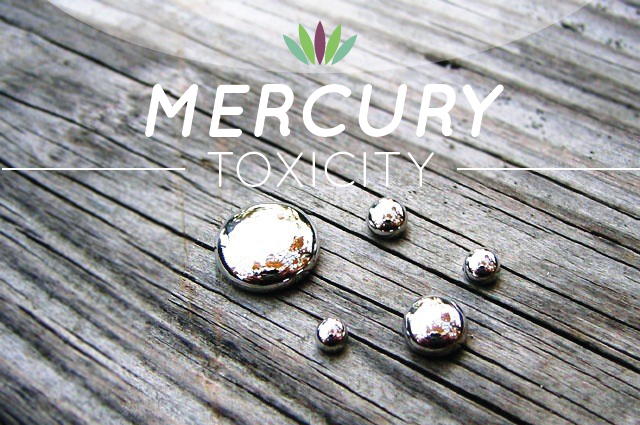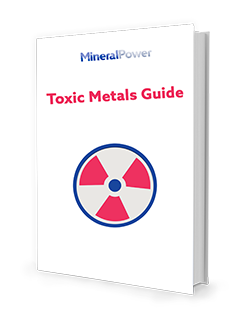Mercury Toxicity

Most people are mercury toxic. Mercury is among the most toxic elements known. In this article, I reveal how to reduce exposure and remove it from our bodies.
Mercury in our environment is contributing to countless chronic health problems today, especially for those who:
- Eat fish or shellfish at least twice weekly
- Has had or has mercury amalgam fillings
As a result of all this exposure, most children today are born with excessive mercury in their bodies. Mercury is a factor in increasing birth defect rates, autism and other developmental delays, ADHD and other learning disorders. Mercury easily passes through the placenta from mother to child. This source (congenital mercury) can be reduced if women reduce their mercury burden before becoming pregnant.
Sources of Mercury
There are three different kinds of mercury:
- Organic (methylmercury): Methylmercury is naturally occurring and bioaccumulates in the environment, especially in fish. As a result, most human exposure to organic mercury comes from eating fish (17, 19).
- Inorganic: Inorganic mercury is most typically found as a white powder and can be found in products such as disinfectants and fungicides (19).
- Elemental mercury: This is form of mercury is a metallic, silvery liquid and what you would find in a thermometer (19). It’s also found in dental amalgams (17). According to the NY state Department of Environmental Conservation, elemental mercury “is a potent neurotoxin that impacts the central nervous system” (19).
Mercury can invade our body in many ways. Here are a just a few of the sources in which it lurks:
- Dental mercury amalgam fillings (15)
- Fish and shellfish (especially tuna, shark and other large fish) (15, 17, 18)
- Disinfectants (19)
- Fungicides (15, 19)
- Soft contact lens solution and eye drops to reduce redness
- Latex and oil-based paints
- Nasal sprays
- Adhesives (15)
- Air conditioner filters
- Air pollution (coal burning) (18, 19)
- Algaecides
- Antiseptics
- Battery manufacturing
- Body powders
- Bleached flour
- Broken thermometers
- Burning of building materials
- Calomel lotions
- Some Chinese herbs
- Cleaners including Ajax, Lysol, Comet, Derma Scrub, Dove Soap, Ivory Liquid
- Chlorine and chlorine bleach (15)
- Coal burning (this is how mercury is released into the environment)
- Congenital intoxication (acquired in utero)
- Cosmetics
- Diuretics
- Dyes
- Embalming fluid
- Engraving supplies
- Exhaust fumes
- Fabric softeners (15)
- Felt (15, 19)
- Fertilizers
- Industrial waste (15)
- Inks
- Laxatives
- Lumber
- Paints
- Paper manufacturing
- Medications
- Photo engraving
- Preparation H
- Psoriasis ointment
- Sewage disposal and sludge (15)
- Skin lightening creams
- Tattoos
- Water (contaminated)
- Waxes (including floor) (15)
- Wood preservatives
Medications
Mercury can be found in many prescription, over-the-counter drugs and personal care products. Mercury is used because it is an excellent germ killer.
Thiazide diuretics, used to lower blood pressure, contain mercury. Other products that may contain mercury include antiseptics, anti-fungal preparations, soaps, contact lens solutions, etc.
Dental Materials
Studies demonstrate that each time one bites down on a mercury filling, some mercury vapor, the most dangerous form of mercury, enters the body. The amount that escapes is tiny, but it occurs thousands of times each day. Mercury fillings that have been in your mouth for more than 15 years degrade at a faster rate. This mercury vapor travels directly to bodily tissues and the brain, an organ easily damaged by mercury. (15, 17)
Large Fish And Shellfish
The major source of mercury exposure for most are fish and seafood. In particular, large fish that eat smaller fish concentrate mercury up to one million times in their body fat and other tissues. Tuna fish is the most widely enjoyed toxic fish. However, all fish, no matter what their size, are contaminated with mercury.
Shellfish, including clams, mussels, oysters, lobster and shrimp all tend to have mercury and other toxic metals such as cadmium, arsenic, lead, and even radioactive waste and other contaminants. This makes them basically unfit for human consumption.
Learn more about how to choose safe seafood in Wendy’s Seafood Survival Guide.
Industry
Mercury is used in industry and manufacturing as a germicide, fungicide, an electrical conductor and more. These industries include electronics, gold mining and the manufacture of paper, chlorine, adhesives, fabric softeners and waxes.
Symptoms of Mercury Toxicity
Hundreds of symptoms may be due to chronic mercury toxicity. The organ most affected is often the brain, and children suffer the most from many mercury-related disorders.
Here is a long list of symptoms and conditions that may be associated with mercury:
- Acne
- Acid Reflux – mercury is a proton pump inhibitor, which reduces stomach acid
- Adrenal fatigue
- Allergies – leaky gut via gut dysbiosis caused by mercury (17)
- Alzheimer’s Disease
- Amylotrophic Lateral Sclerosis (ALS)
- Ankylosing spondylitis
- Aneurysm
- Anger
- Anorexia (9, 15)
- Anxiety (9, 17, 18)
- Apathy
- Asthma
- Ataxia (15, 17)
- Autism (11)
- Autoimmune Disease
- Arterial sclerosis – Mercury activates an enzyme called phospholipase D (PLD) in cells, which line blood vessel walls (endothelial cells). This activation causes the release of phosphatidic acid which damages the cells.(2) These damaged cells then accumulate cholesterol-based plaque leading to arterial sclerosis.
- Attention Deficit Disorder (ADD)
- Attention Deficit Hyperactivity Disorder (ADHD)
- Birth defects (15, 19)
- Blushing (15)
- Borderline Personality Disorder
- Brain Fog (17)
- Bruising
- Bruxism – Grinding Teeth While Sleeping
- Bulimia
- Calcium, Elevated Blood
- Cancer
- Chronic Fatigue (18)
- Colitis
- Constipation
- Coronary Vascular Disease – Kuopio Ischemic Heart Disease Risk Factor (KIHD) study: 2,005 men without heart disease are divided into four groups based on hair-mercury content and tracked for an average of 12 years. Those in the top 25 percent for hair mercury had a 60% increased risk of death from CVD. Those same men had a 70% increased risk of coronary heart disease.(8)
- Crohn’s Disease
- Dementia
- Depression (15, 17, 18)
- Dermatitis (15, 19)
- Developmental delays (19)
- Dizziness (15)
- Dysarthria (characterized by slurred or slow speech due to weakness or poor control over the muscles used for speech) (15, 17, 19)
- Dysbiosis – mercury kills good gut bacteria
- Enlarged Prostate (Elevated DHT)
- Fatigue (9, 15, 17)
- Flatulence (gas)
- Floaters In the Eyes
- Fibromyalgia
- Gastritis
- Hair loss (Balding—Elevated DHT) (17)
- Headaches (9, 15)
- Hearing loss (15, 17)
- Heart Arrhythmia (irregular heartbeat)
- High Cholesterol
- Homocysteine, Elevated (increases risk of heart disease)
- Hormonal dysregulation including abnormal menstrual cycles and infertility (17)
- Hyperactivity (15, 18)
- Hypoglycemia/Hyperglycemia
- Hyperacusis (sensitivity to certain sounds)
- Hypertension (17)
- Immune Suppression/ Immune System Dysfunction (15)
- Insomnia (15, 19)
- Iodine Deficiency
- Irritability (19)
- Irritable Bowel Syndrome (IBS)
- Juvenile Arthritis
- Kidney Damage (15, 19)
- Leaky Gut Syndrome
- Learning Disabilities
- Lupus
- Manic Depressive Disorder
- Memory Loss (15, 19)
- Mole Formation (especially on the neck, underarms, inner thighs, and feet)
- Mood Swings (15, 19)
- Multiple Chemical Sensitivity (MCS) (17)
- Multiple Sclerosis
- Muscle Tremors (9, 15, 17, 19)
- Myasthenia Gravis
- Nausea and vomiting
- Nervousness (15)
- Numbness and tingling or “Pins and Needles” Sensation (15, 19)
- Obsessive-Compulsive Disorder (OCD)
- Oily Skin (Elevated DHT)
- Pain
- Panic attacks
- Paresthesis or neuropathy (17)
- Parkinson’s Disease
- Phobias
- Photophobia (sensitivity to light from weak iris response)
- Rashes (15, 19)
- Rheumatoid Arthritis
- Salivating, Excessive
- Schizophrenia Spectrum Disorders (15)
- Sciatica
- Excessive Shyness (9, 19)
- Sleep Disorders (9, 17)
- Suicidal Thoughts
- Spider Veins
- Selenium Deficiency
- Thyroid Disorders like Hypothyroidism (15)
- Tinnitus (Ringing In the Ears)
- Transient ischemia attacks or stroke (17)
- Vision Impairment, loss Of peripheral vision (by altering interocular fluid eye pressure) (9, 15, 19)
- Vitamin C Deficiency
- Weakness in muscles (15)
- Weight Gain
- White Coating On the Tongue
- Yeast Syndrome/Candida
- Zinc Deficiency
Detection of Mercury Exposure
Blood tests are practically useless to detect mercury unless you’ve had a recent exposure because the body removes mercury from the blood to store it away from vital organs. Mercury is stored in the tissues of the brain, kidneys and liver. The best methods of detection for mercury are hair mineral analysis and urine metals push tests using chelating agents that favor mercury.
Hair Mineral Analysis
As any amount of mercury is toxic, even small amounts of mercury on an HTMA (Hair Tissue Mineral Analysis) is undesirable. Any hair level of mercury above 0.02 mg% is excessive. Mercury does not always deposit into the hair to show on an HTMA. A hair mineral analysis provides many indicators of hidden mercury toxicity even if mercury itself is not presenting on an HTMA. These include:
- An elevated copper above about 2.5 mg%. Mercury toxicity is usually found if copper toxicity is present.
- Hidden copper toxicity indicators such as a high hair calcium, a low hair potassium, a low sodium/potassium ratio and a low zinc level.
- Elevated levels of cadmium, arsenic or aluminum often indicate the presence of hidden mercury.
Urine Test
A Urine Toxic and Essential Elements Test is another way to detect the presence of mercury. Some people are not able to detox mercury into the hair. By using chelators like DMSA or cilantro extract, you can ‘push’ mercury, and many metals not on an HTMA, into the urine and get a good picture of the body burden of mercury. I prefer to use both methods, urine and hair mineral analysis, to determine one’s toxicity levels.
Reducing Your Exposure
Reduce Fish In Your Diet
To reduce mercury exposure, completely avoid tuna fish and larger species of fish. Other fish known to be high in mercury include sea bass, marlin, shark, halibut, pike, walleye, swordfish and bass. Also, it is best to avoid slightly less contaminated fish such as mahi mahi, cod, pollack, salmon from the Great Lakes, channel catfish (wild) and lake whitefish.
Fish that are considered safer include trout (farmed), catfish (farmed), fish sticks, flounder (summer), sardines, mackerel, anchovies, salmon (wild Pacific), croaker and haddock.
Learn more about how to choose safe seafood in my Seafood Survival Guide.
Avoid All Shellfish
Mercury is just one reason to avoid all shellfish, even though they are tempting and formerly were one of my favorite foods. Shellfish are also often high in cadmium, nickel, arsenic, aluminum and many toxic metals found in the coastal shelves of every nation.
Replace Dental Amalgams
I advise anyone with mercury amalgam fillings to have them replaced, preferably by a biological dentist. I don’t recommend doing this all at once, but doing a few fillings at a time in stages. Mercury amalgams undoubtedly leach mercury into your body, but also contain nickel, tin, aluminum and sometimes palladium – all toxic metals. Mercury fillings older than 15 years ten to leach more metals into the body as they become less stable over time.
Takeaway
If you are concerned about mercury exposure, an HTMA is a great place to start. It can give you the information you need to address the root causes of physical and mental health issues. If you suspect you have a build-up of toxins or a micronutrient imbalance, or you have unexplained symptoms like brain fog, weight gain, fatigue, or hair loss, you will certainly benefit from getting an HTMA.
After a long search and after having worked with multiple labs, I send all of our hair samples to an internationally-recognized lab that is a world leader in HTMA laboratory services. They’ve run more than 100,000 tests, and they process hair samples without washing them, which sets them apart from many other labs (washing a sample removes minerals, which leads to inaccurate results for proper interpretation).
If you think you may have toxin build-up or a mineral imbalance and you want definitive, accurate data on your health, you can order your HTMA here.
*These statements have not been reviewed by the FDA. A Hair Mineral Analysis (HTMA) is not intended to diagnose, treat, cure, reverse, or prevent any disease. It is not intended to replace any other medical test(s) that may be prescribed by your medical doctor.
Click Here for References+
1. Casdorph, H.R. and Walker, M., Toxic Metal Syndrome, Avery Publishing, New York, 1995.
2. Dental Truth Magazine, published by DAMS International, 1079 Summit Ave, St. Paul, MN 55101, (800) 311-6265.
3. Droesti, I.E. and Smith, R., Neurobiology of the Trace Elements, Vol II, Neurotoxicology and Neuropharmacology, Humana Press, 1983.
4. Huggins, H., It’s All In Your Head, The Link Between Mercury fillings And Your Health, Avery Publishing, NY, 1993.
5. Pfeiffer, C., Mental And Elemental Nutrients, Keats Publishing, Ct., 1972.
6. Schroeder, H.A., The Trace Elements And Man, Devin-Adair Company, Old Greenwich, Ct., 1973.
7. Wilson and Eck, Toxic Metals In Human Health And Disease, Eck Institute of Applied Nutrition and Bioenergeteics, Ltd., Phoenix, AZ, 1989.
8. Wilson, Sauna Therapy, LD Wilson Consultants, Inc., 2006. http://drlwilson.com/articles/sauna_therapy.htm
9. Agency for Toxic Substances and Disease Registry. “Health Effects of Mercury Exposure.” http://www.atsdr.cdc.gov/mercury/docs/HealthEffectsMercury.pdf
10. Sandborgh Englund G, Dahlqvist R, Lindelöf B, Söderman E, Jonzon B, Vesterberg O, Larsson KS. “DMSA administration to patients with alleged mercury poisoning from dental amalgams: a placebo-controlled study.” J Dent Res. 1994 Mar;73(3):620-8. http://www.ncbi.nlm.nih.gov/pubmed/8163732
11. Yassa HA. “Autism: a form of lead and mercury toxicity.” Environ Toxicol Pharmacol. 2014 Nov;38(3):1016-24. doi: 10.1016/j.etap.2014.10.005. Epub 2014 Nov 6. http://www.ncbi.nlm.nih.gov/pubmed/25461563
12. Cao Y, Skaug MA, Andersen O, Aaseth J.”Chelation therapy in intoxications with mercury, lead and copper.” J Trace Elem Med Biol. 2015;31:188-92. doi: 10.1016/j.jtemb.2014.04.010. Epub 2014 May 14. http://www.ncbi.nlm.nih.gov/pubmed/24894443
13. Rafati-Rahimzadeh M, Rafati-Rahimzadeh M, Kazemi S, Moghadamnia AA. “Current approaches of the management of mercury poisoning: need of the hour.” Daru. 2014 Jun 2;22:46. doi: 10.1186/2008-2231-22-46. http://www.ncbi.nlm.nih.gov/pubmed/24888360
14. Blaucok-Busch E, Amin OR, Dessoki HH, Rabah T.”Efficacy of DMSA Therapy in a Sample of Arab Children with Autistic Spectrum Disorder.” Maedica (Buchar). 2012 Sep;7(3):214-21. http://www.ncbi.nlm.nih.gov/pubmed/23400264
15. Analytical Research Labs. “Mercury.” http://www.arltma.com/Articles/MercuryToxDoc.htm
16. Kresser, Chris. “Mercury Toxicity, Kids & Fish Consumption.” January 28, 2016. http://chriskresser.com/mercury-toxicity-kids-fish-consumption/
17. Kresser, Chris. “Could Mercury Toxicity Be Causing Your Symptoms?” August 11, 2015. Updated June 28, 2019. http://chriskresser.com/could-mercury-toxicity-be-causing-your-symptoms/
18. Dr. Mercola. “What You Need to Know About the Different Forms of Mercury, the Next Generation of Mercury Testing, and How to Detox Safely.” January 6, 2013. http://articles.mercola.com/sites/articles/archive/2013/01/06/dr-shade-on-mercury-exposure.aspx
19. New York State Department of Environmental Conservation. “What Do You Know About Mercury?” http://www.dec.ny.gov/chemical/28716.html










Great article. Thank you so much for sharing it.
Great article! Thanks for this overview and the helpful warnings and tips.
Could you find another link to replace http://www.mercuryexposure.com/? Nothing is at that address now.
Do amalgam fillings need to be removed before using any or all detoxes?
ABSOLTELY NOT. an amalgam is merely one source of toxicity. If you wait to detox until you can remove fillings you can end up getting sicker. I don’t see any sense in waiting. A lot of detox products will affect other metals you have and not mercury so they are great to take – like Biosil for instance.
I had 2 silver filling removed not the proper way. I ended up in bed sick. Had lots of symptoms. i have less symptoms now. Im getting a Oligo Scan done Jan 24 to check for toxins and minerals. I cant wait !
Congrats! The oligo scans are neat. The are very accurate.
SAdly, many people have the same experience. But if you think about it, those amalgams were releasing mercury every day they were in your mouth, you just got a huge dose when they were removed. I would recommend anyone getting amalgams removed do it with a biological dentist and take natural chelators like coriander seed oil or cilantro tincture or even DMSA for a couple months after removal to prevent all the mercury from entering the body – even it removal is done with a biological dentist.